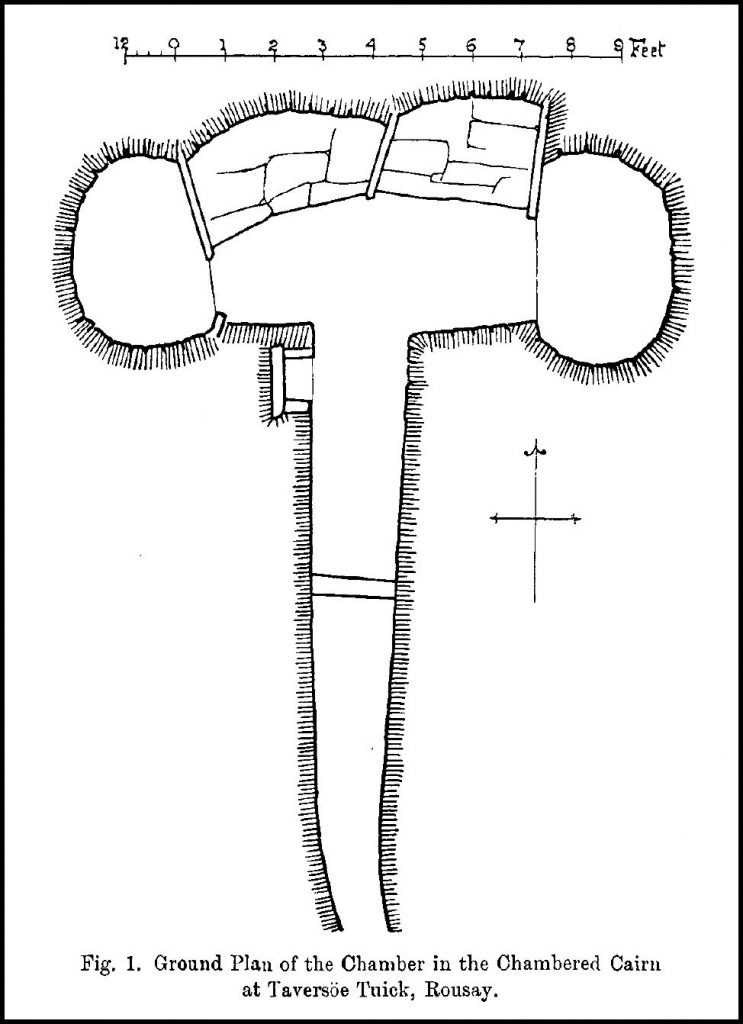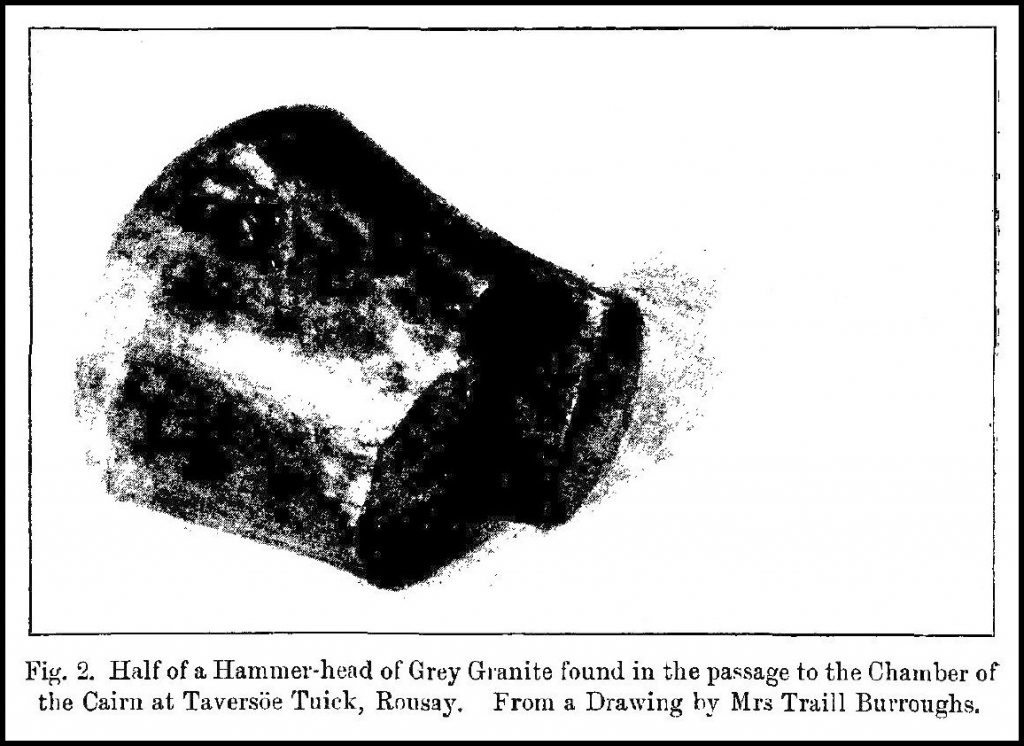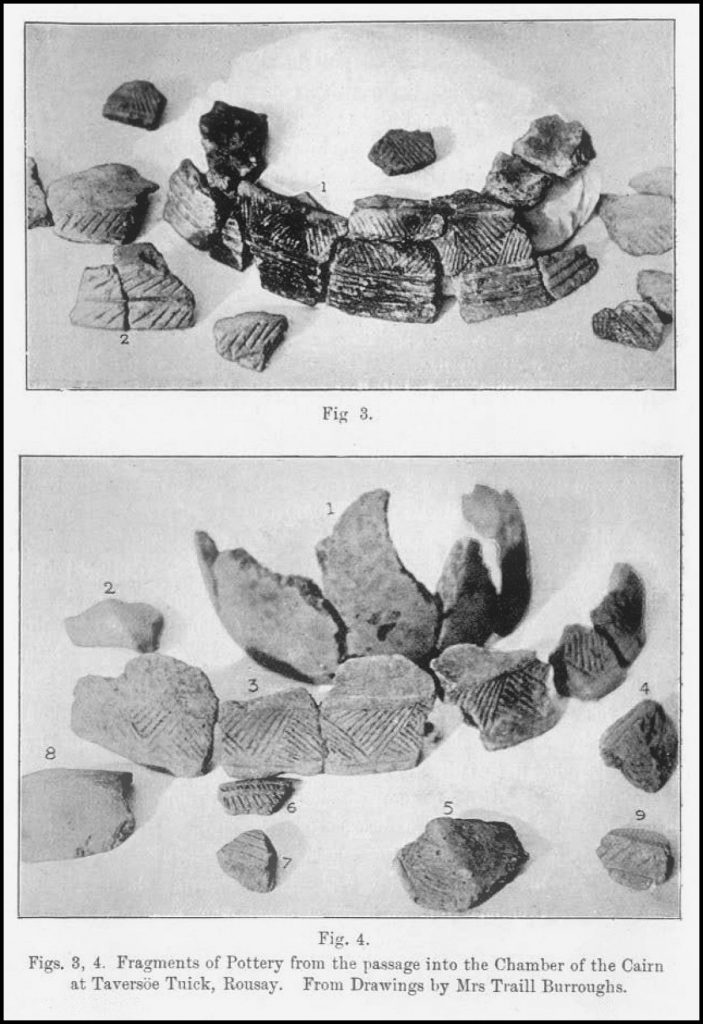AN ACCOUNT OF A CHAMBERED CAIRN AND CREMATION CISTS AT TAVERSOE TUICK,
NEAR TRUMLAND HOUSE, IN THE ISLAND OF ROUSAY, ORKNEY,
EXCAVATED BY LIEUTENANT-GENERAL TRAILL BURROUGHS, C.B., 0F ROUSAY, IN 1898.
by
SIR WILLIAM TURNER, K.C.B., LL.D., D.C.L., F.S.A. Scot.
In the month of May 1898 I received from Lieutenant-General Traill Burroughs, C.B., of Rousay, Orkney, a box containing some human bones and other objects which had been obtained whilst excavating a mound on his property of Rousay. From letters which General Burroughs has written to me, and from sketches made by himself and Mrs Traill Burroughs, I have compiled the following description.
The mound is situated on Flagstaff Hill, near his residence, Trumland House, and is known by the local name of Taversoe Tuick. It was about 4½ feet above the natural lie of the ground on its lower or southern side, and about 2 feet on the northern or upper side. It was circular at the base and had a diameter of about 30 feet. The surface was overgrown with heather, but with grass at the apex, and the bulk of the mound was composed of loose stones and earth.
The excavations were begun in order to make a summer-seat on the mound to face the south, which commands a fine prospect, and to be protected from the north and east. With this object a wedge-shaped block was cut out of the south aspect of the mound, and as that did not suffice for the purpose required, the excavation was carried further into the mound at the apex of the wedge, in the form of a semicircle. A rough stone wall was exposed near the north face of the mound, about a foot below the surface. It was built of flat stones placed horizontally, with an upright flat stone at each end, and the ends were 4 feet apart. The stone to the west was 33 inches in height and entirely concealed in the mound; that to the east was 41 inches in height, and its upper end projected into the grassy covering of the mound for a few inches, but it did not attract attention until its continuity with the concealed part of the stone was observed.
The excavation was then continued to the immediate south of this wall, when three stone cists in close proximity to each other and to the stone wall were exposed. One of the cists was situated at the foot of the tallest upright stone. Unfortunately they had been broken by the workmen before General Burroughs saw them, so that their exact dimensions cannot be given. The cists are described as “small,” and not more than from 1½ to 2 feet in length and breadth, but the length rather exceeded the breadth. They were constructed of undressed flat stones, and the cover-stones were about one inch and a half thick. They contained fragments of whitened bones, which General Burroughs is inclined to think had been contained in urns lodged in the cists. The cists had been built on a layer of earth about a foot thick; when this was removed, the stone roof of an underground chamber was exposed 4 feet 3 inches below the surface of the ground. The two upright stones and the foundations of the wall discovered earlier in the excavation rested on the roof of this chamber at its northern end. As the excavation proceeded this chamber was more fully exposed. Its roof was formed of five large lintel stones, the long axes of which ran north and south. They rested on the end and side walls, and varied in length, as far as visible, from 4 feet 2 inches to 5 feet 2 inches, and in breadth from 2 feet 1 inch to 3 feet. The middle stone was broken; the two on the east side were entire; of the two westmost stones, one was cracked in two, the other crumbled into flakes and had to be removed. The stones forming the roof were massive flags, which varied in thickness from 3 to 10 or 11 inches.

The chamber itself (fig. 1) consisted of a central part and four recesses or alcoves – two at the north end, one at the east, and another at the west – and the flagstones just referred to roofed in both the body of the chamber and the recesses. The interior measurements of the entire chamber with its recesses were 12 feet in length, 5 feet 4 inches in width, and 4 feet 8 inches in height. The eastern recess was 4 feet 2 inches long by 2 feet 4 inches in width, and 2 feet 11 inches in height; that at the north-east was 3 feet in length by 2 feet 4 inches in breadth, by 3 feet 5 inches in height; that at the north-west was 3 feet 6 inches in length by 1 foot 11 inches in breadth, by 3 feet 10 inches in height; and that at the west was 3 feet 7 inches in length by 3 feet in breadth, by 4 feet in height. Each recess approximated in outline to a semicircle.
The stones which lined it were arranged so as to form a beehive-like alcove; passing horizontally across each recess and raised about a foot above the paved floor was a flagstone, which divided the recess into an upper and a lower compartment, both filled with dark greasy mud. The side walls of the chamber were built of flat stones, and similar flags formed its floor. A skeleton bent upon itself was found in the north-west recess. Fragments of a human skeleton were also found in the north-eastern recess. In removing the earth which had fallen into the chamber numerous pieces of broken pottery were found, so that several urns had probably been deposited there. There were no signs of cremation in the chamber itself.
The chamber at its south aspect opened into a long passage, which ran to the south face of the mound, and ended outside the mound about 15 feet from the interior of the chamber. The earth which concealed it was from 1 to 3 feet in thickness, and was covered by strong heather, so that there was no indication on the surface of the existence of the passage. Where it left the chamber it was 3 feet 9 inches high and 2 feet wide, and about 12 feet from the chamber it diminished to 2 feet 4 inches in height and 1 foot 9 inches in width, and it seemed as if it was continued into a passage smaller in all its dimensions, which General Burroughs speaks of as a drain. About 2 feet 6 inches from the chamber a small recess was found in the west wall of the passage about 1 foot 8 inches above the floor of the passage. The long axis of the recess, 2 feet 4 inches, was parallel to that of the passage, its breadth was 1 foot 4 inches, its height was 11 inches. It was bounded by an upright stone built into the wall, which did not project into the passage. This stone was 2 feet 3 inches in height, 2 feet in breadth, and 6 inches in thickness.
The walls of the passage were formed of flag-like stones placed horizontally, and the passage was paved with flags about 1½ inches thick.

At about 13 feet 6 inches from the chamber a block of stone lay in its long diameter across the passage and fitted into the wall on each side. It rested on the floor, and projected from it to the height of 12 inches. Its long diameter, so far as was visible, was about 1 foot 9 inches, and it was 1 foot in breadth. From its position it formed an imperfect barrier against entrance into the proximal part of the passage and the chamber. The narrow drain-like continuation of the passage was traced for a distance of 15 feet from the chamber, and gradually diminished in width and correspondingly in height. At the end furthest removed from the chamber it bent somewhat to the east, but it has not yet been traced to its ultimate termination. Although drain-like in its mode of construction, it obviously could not have acted as a drain, as the stone barrier would have checked a flow outwards from the chamber.
Three heaps of bones, representing probably as many skeletons, were found in the passage between the chamber and the barrier stone.
Immediately to the south of the barrier stone the broken half of a hammer-head of smooth grey granite (fig. 2), about 2 inches in diameter, was found, and not far from it a flake of flint, triangular in shape, which might have been used as a scraper. Somewhat further away from the barrier numerous broken portions of urns were seen on the floor of the passage, mixed with earth, black mud, and fragments of bone.
As the small cists found superjacent to the roof of the chamber had been broken by the workmen, and their contents in great measure scattered about before they were seen by General Burroughs, their exact condition before they were disturbed cannot, unfortunately, be stated in greater detail than has already been given. The specimens sent to me for examination were collected from at least two of the three cists, and in large part consisted of numerous fragments of bone, which from their greyish-white appearance, with, in some specimens, blackening of the cancellated tissue, and less frequently of the compact shell of the bone, had obviously been incinerated. Sometimes they were contorted, and had cracks extending into their substance. When struck, they had a metallic ring and were almost devoid of animal matter. As a rule, the fragments were so small as to make it impossible to state in most cases which bones of the skeleton they had been parts of, though many of them were, without any doubt, from the long bones of the limbs; two specimens were, from their size and markings, obviously sections of the thigh-bones, two others were parts of ribs, another was a portion of a vertebra, several flat fragments had belonged to bones of the head, and the terminal phalanx of one of the fingers was also fairly well preserved. They were undoubtedly human bones from an adult, or possibly more than one full-grown person. A fragment of the dentary border of an upper jaw-bone was also recognised, which, from the small size of the alveoli for the lodgement of the fangs of the teeth, was apparently that of a child.
Many of the fragments of bone were attached to or even embedded in nodular masses of hard vitrified slag, the surface of which not unfrequently was smooth and iridescent. Some of the nodules were broken across and found to be hollow in the interior, as if from the presence of air cavities. From their appearance one was led to think that during the cremation of the bodies, so intense a heat had been generated that a slag had been produced, which had in many instances fused with the bones. Through the courtesy of Dr Leonard Dobbin, of the Chemical Laboratory in the University, an analysis of the slag has been made. It consisted of aluminium, calcium, magnesium, with small quantities of iron and potassium, and the salt radicals of phosphoric and silicic acids. As it required a bright yellowish heat to fuse the slag, it had obviously been originally produced at a high temperature.
Numerous fragments of broken pottery were mingled with the bones, so that the opinion formed by General Burroughs, that each cist had contained an urn, was without doubt correct. There can, I think, be little question that after cremation the incinerated bones had been deposited in an urn, which had been placed mouth downwards on a flat stone on the earthen floor of a cist of a size about sufficient to accommodate it. These cists were therefore cremation cists, and quite different in character from the short cists so frequently found in Scotland, in which an uncremated body had been buried in the bent posture. The urns had been broken into such small fragments that a restoration was impossible. The paste was unglazed and of a moderately coarse texture, and the outer surface was a light brick colour. Even the small fragments were proportionately heavy, so that there was probably a considerable percentage of iron in the clay which had been used to form the urn. I did not see incised lines on any of the fragments from the cremation cists.
In addition to the remains obtained from the cremation cists, General Burroughs forwarded to me objects lying in the underground chamber and the passage leading out of it.
As stated in the previous description, unburnt human skeletons were found in the chamber, one of which was bent upon itself, so that the chamber had obviously been used as a place of sepulture for unburnt bodies. It is greatly to be regretted that the bones which I received were so much broken, and the fragments, as a rule, were so small that it was impossible to reconstruct either the long bones or a skull. Fragments of at least five adult femora were recognised, which represented three individuals; portions of tibiae, fibulae, and an astragalus and a clavicle were also fairly well preserved. The skull was that of an adult, but from its fragmentary state it is not possible to say whether the proportions were dolichocephalic or brachycephalic. The left half of the lower jaw was preserved, and the true molar teeth were all in place and worn flat by use. From the slenderness of the clavicle and the comparatively feeble muscular ridges on some of the long bones, I am disposed to think that at least one of the skeletons had been that of a woman.

The upper ends of two tibiae, though imperfect, showed distinctly the retroversion of the head of that bone which has so frequently been observed in the tibiae from Neolithic and Bronze Age interments, and the broken shafts had a moderate amount of platyknemia. In only one femur was the upper third of the shaft sufficiently entire to enable me to recognise the antero-posterior flattening known as platymery, a condition frequently seen in skeletons from these interments.
Fragments of bone obtained from the long passage were from one or more skeletons which had been cremated. The fragments had characters similar to those described from the cremation cists situated on the roof of the underground chamber. They were mingled with nodules of slag like those already described. There was no difficulty in recognising the human character of some of the incinerated fragments.
The pottery found in the passage was-formed of a very coarse paste. The largest fragment sent to me, 4½ inches in one direction by 3 inches in another, and about 1 inch in thickness, was obviously a portion of the base of an urn, without doubt a cinerary urn of some magnitude. Some other fragments (figs. 3, 4) in the possession of General Traill Burroughs showed the obliquely incised lines which are so common a decorative feature of this primitive pottery.
Both in the chamber and its passage stones were found which in part had fallen in during the excavation, and were of no archaeological interest. One stone has, however, attracted my attention. It is a flake, apparently, of sandstone, attenuated at one end into a sort of handle, and expanded at the other into a hammer-like head. Its length is 10½ inches and its greatest width 6¾ inches. The margins of the part which might have been used as a handle were comparatively smooth, and a hollow in one margin readily accommodated the thumb when it was grasped by the hand. It did not show any marks of chipping, as if made artificially, but was probably a natural flake, of convenient shape to be used as a tool.
Extracted from
The Proceedings of the Society of Antiquaries of Scotland,
Volume 37, pp. 73-82 1902-03
Available in the Orkney Room at Orkney Library & Archive